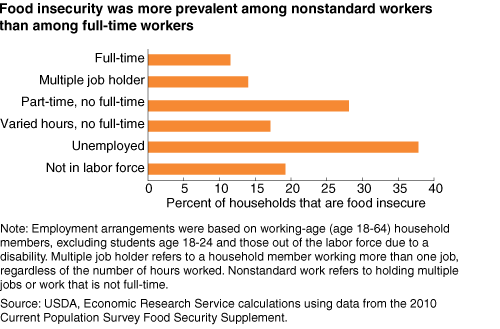Food Insecurity More Common for Households With Nonstandard Work Arrangements
- by Alisha Coleman-Jensen
- 6/5/2012
In 2010, 14.5 percent of U.S. households were food insecure or had difficulty putting enough food on the table. Food insecurity rates were higher for households with members in nonstandard work arrangements--multiple jobs, part-time work, or jobs in which the minimum number of hours worked varied from week to week--than for households with members in full-time jobs. For example, 11.5 percent of households with one or more members engaged in full-time work were food insecure in 2010, while 28.0 percent of households with a member engaged in part-time work were food insecure.
Is it just the lower income from nonstandard work arrangements that results in higher food insecurity, or is the nonstandard work schedule itself making it harder for households to meet their food needs? A recent study using data from 2003-05 Current Population Surveys explored the association between household food insecurity and different types of work arrangements. Among households with otherwise similar characteristics, including income, those with members in nonstandard work arrangements were more likely to be food insecure than those with members in full-time jobs.
Households were categorized into one of the following ranked and mutually exclusive work arrangements: multiple job holder (regardless of the number of hours worked), full-time, part-time, varied hours, unemployed, or not in the labor force (not looking for work). Categorizations were based on the work characteristics of the working-age household member with the highest ranking work arrangement. For example, if no working-age member had multiple jobs but one worked full time, the household was categorized as 'full-time.' A working-age member was defined as someone who was between the ages of 18 and 64 and able to work; the sample excluded students age 18-24 and adults who were out of the labor force due to a disability. The study accounted for the effects of annual household income, household composition, educational attainment, household size, and other demographic characteristics.
Households with members holding down multiple jobs were 43 percent more likely to be food insecure than households with members in full-time jobs. Households relying on part-time workers and workers with varied work hours were 19 and 30 percent, respectively, more likely to be food insecure than households with workers in full-time jobs.
These findings suggest that employment relates to food insecurity in ways beyond the effects of earned income. Instability in income and work schedules may affect a household's ability to budget money and time for obtaining food. Expected earnings may be unpredictable for households in jobs with varied hours. Working multiple jobs may reduce the time available for preparing low-cost meals. Employment may help protect households from food insecurity, but this research suggests that not all work arrangements offer equal protection.
This article is drawn from:
- 'Working for Peanuts: Nonstandard Work and Food Insecurity Across Household Structure'. (2011). Journal of Family and Economic Issues. Vol. 32, No. 1, pp. 84-97.
We’d welcome your feedback!
Would you be willing to answer a few quick questions about your experience?


